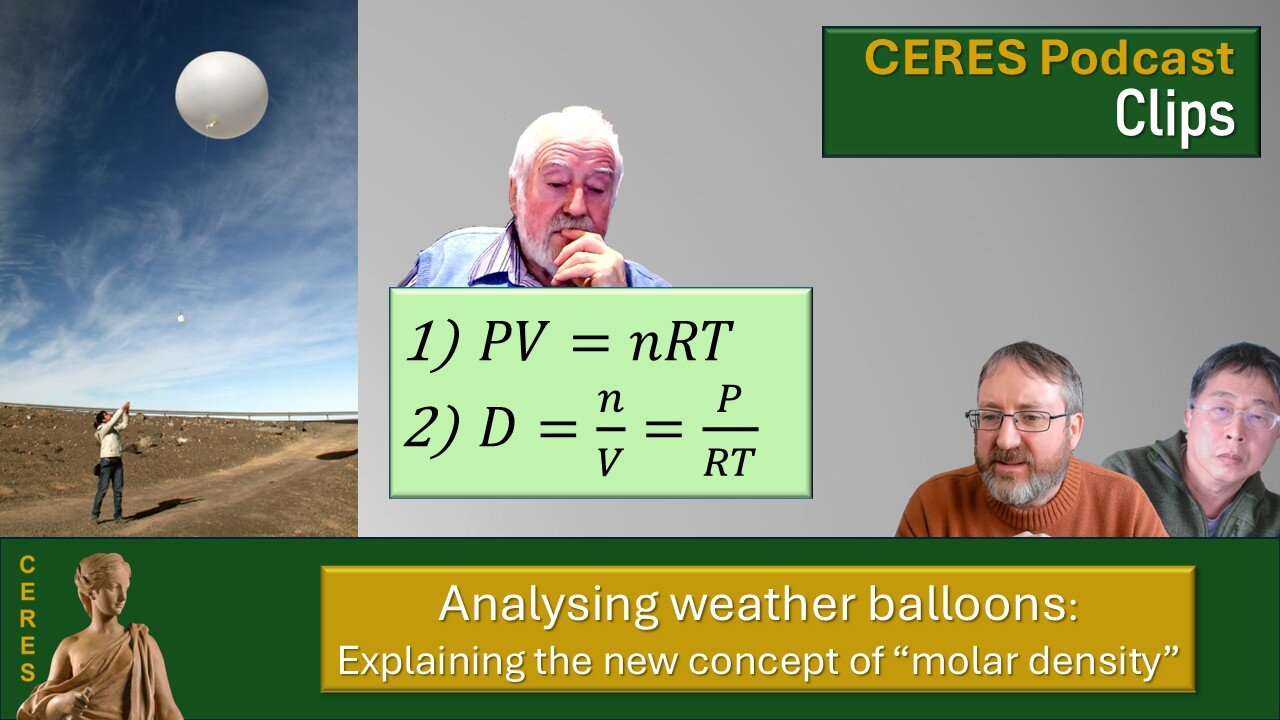Premium Only Content

Using weather balloons to study the Earth’s atmosphere: the new concept of molar density
In this clip from Episode 1 of the CERES Podcast, the CERES team leaders (Dr. Willie Soon, Dr. Ronan Connolly & Dr. Michael Connolly) describe some of the published research of the CERES team.
In this episode, Michael, will focus on the use of “molar density” to analyze weather balloons and the surprising previously undiscovered insights this technique is revealing about the Earth’s atmosphere.
This is quite a technical clip. If you’re not already familiar with the concepts, it might be hard to take in all the information in one viewing. However, if you are interested in trying to understand how the Earth’s atmosphere behaves, we recommend studying this material carefully.
🔹 🔹 🔹
Chapters:
00:00 The use of molar density to analyze weather balloons
04:20 What data do weather balloons provide and where can you download them?
08:45 What is the molar density?
13:53 The surprising bi-linear result that is occurring constantly around the world in the atmosphere
21:16 Using molar density to calculate mass fluxes and evaluating the so-called “Hadley Cell” model
24:30 The theory behind the Hadley Cell concept
27:17 How the mass flux measurements show the Hadley Cell concept was wrong
34:11 Using molar density to calculate the tropopause more efficiently
40:02 Final comments
Link to the full podcast episode: https://rumble.com/v6q2d84-wildfires-to-weather-balloons-debunking-the-97-of-scientists-agree-myth-cer.html?e9s=src_v1_ucp
🔹 🔹 🔹 🔹
⭐ If you want to support the work of CERES, please visit us at https://www.ceres-science.com/support-us
🔹For more about Dr. Ronan Connolly & links to his social media channels, visit https://ronanconnollyscience.com/
🔹 🔹 🔹 🔹
Relevant Links:
⭐ Good sources for weather balloon data if you want to do your own analysis:
❶ University of Wyoming’s “Atmospheric Soundings” website. Great for exploratory research. Easy to download a few balloons and look at in Excel. http://weather.uwyo.edu/upperair/sounding.html
❷ NOAA’s Integrated Global Radiosonde Archive (IGRA). Better for more systematic research. All balloons back to the early 20th century. Suitable for analysing with computer scripts. 20 Gigabytes (20 Gb) https://www.ncdc.noaa.gov/data-access/weather-balloon/integrated-global-radiosonde-archive
⭐ Our papers on this topic:
❶ For Michael & Ronan’s working papers (2014): https://oprj.net/
❷ Mass flux paper: Connolly et al. (2021). https://doi.org/10.3390/atmos12111439
❸ Tropopause paper Connolly et al. (2024). https://doi.org/10.1029/2024EA003584
-
 11:16
11:16
CERES-Science
6 months agoGlobal greening: How “CO2 pollution” is actually making Earth greener
123 -
 1:03:23
1:03:23
Tactical Advisor
13 hours agoNew Gun Unboxing | Vault Room Live Stream 044
235K39 -
 19:12
19:12
Robbi On The Record
14 hours ago $19.02 earnedThe Loneliness Epidemic: AN INVESTIGATION
70.4K94 -
 14:45
14:45
Mrgunsngear
1 day ago $113.27 earnedFletcher Rifle Works Texas Flood 30 Caliber 3D Printed Titanium Suppressor Test & Review
121K29 -
 17:17
17:17
Lady Decade
1 day ago $8.18 earnedMortal Kombat Legacy Kollection is Causing Outrage
79.7K14 -
 35:51
35:51
Athlete & Artist Show
1 day ago $14.15 earnedIs Ryan Smith The Best Owner In The NHL?
92.5K12 -
 22:56
22:56
American Thought Leaders
2 days agoCharles Murray: I Thought Religion Was Irrelevant to Me. I Was Wrong.
75.8K39 -
 36:22
36:22
Brad Owen Poker
15 hours agoGIGANTIC $17,000+ Pot In BOBBY’S ROOM! TRAPPING Top Pro w/FULL HOUSE!! Big Win! Poker Vlog Ep 326
80K9 -
 3:53
3:53
GreenMan Studio
1 day agoRUMBLE RUNDOWN: DREAM HACK SPECIAL W/Greenman Reports
64.6K13 -
 1:28
1:28
Damon Imani
2 days agoThey Laughed at Trump’s Cognitive Test — Damon Made Them REGRET It!
61.7K40